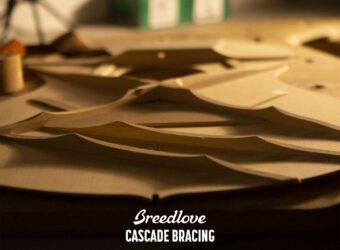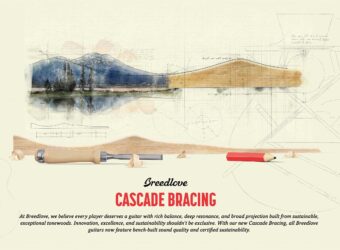
1. What is Bracing, and Why Does it Matter?
Bracing is the internal framework of an acoustic guitar, made up of carefully placed wooden strips supporting the guitar’s top and back. This structure is essential for stability, but it also shapes the guitar’s sound by controlling vibrations and resonance. Bracing design impacts everything from volume and sustain to tonal balance, making it a crucial aspect of a guitar’s overall sound quality.
2. What is Breedlove Sound Optimization?
Breedlove’s Sound Optimization process is a unique, advanced hand-voicing technique that is applied to every USA-made guitar. Traditional guitar making follows fixed specifications, but the Breedlove team treat each guitar as a unique custom shop build. Using precise analysis and measurements, they hand-tune each guitar’s top and back to ensure that it performs exactly how they want each model to sound, achieving Breedlove’s targeted tonal quality. Sound Optimization creates instruments that sound vibrant, consistent, and rich, eliminating the need for players to search for “the good one.” With Breedlove Sound Optimization, every guitar is made to deliver the best sound right from the start. If you would like to learn more about this process, we suggest this great article.
3. What is Cascade Bracing?
In addition to Sound Optimization, Breedlove has developed Cascade Bracing, a system found on all Organic Pro and Eco Collection guitars. Cascade Bracing embodies the trickle-down benefits of Breedlove’s R&D and American ingenuity, bringing carefully refined sound engineering to more accessible models. By incorporating specialized bracing patterns unique to every body shape, Breedlove provides the benefits of advanced acoustic design in every guitar, enhancing tone, projection, and clarity across their range. Still curious about Cascade Bracing? Learn more here.
4. The Result: The Best Sounding Guitars on the Market
With innovative bracing, meticulous sound optimization, and advanced Cascade Bracing, Breedlove guitars are crafted to deliver an exceptional acoustic experience. Every model is built to sound alive, balanced, and inspiring, setting Breedlove apart in the industry.
Experience the Breedlove Difference Today! Discover the sound for yourself—visit your local dealer and ask to try a Breedlove guitar. Experience the Breedlove difference and hear the incredible quality that comes from our commitment to excellence.



